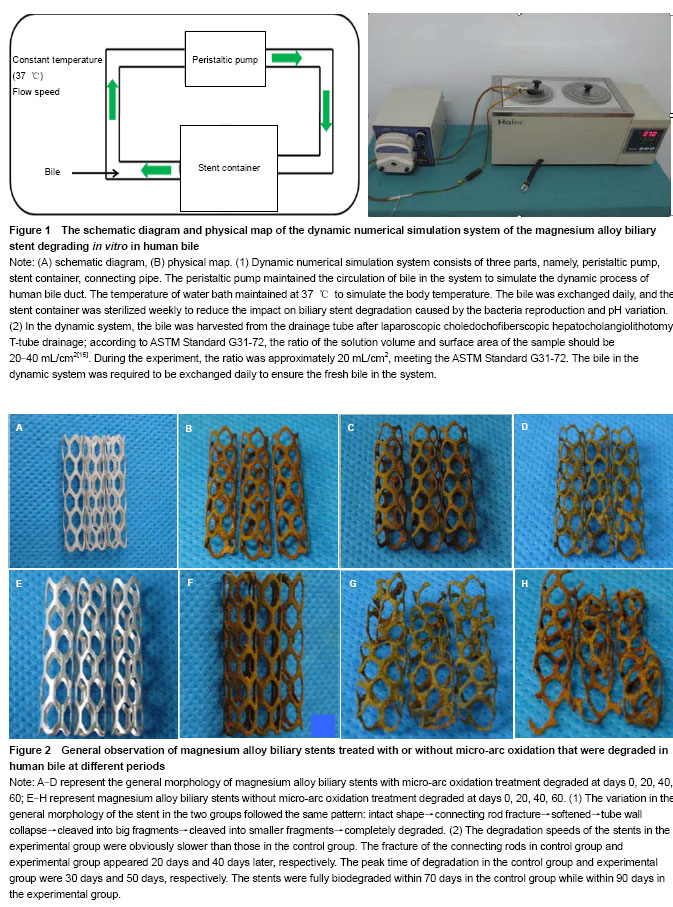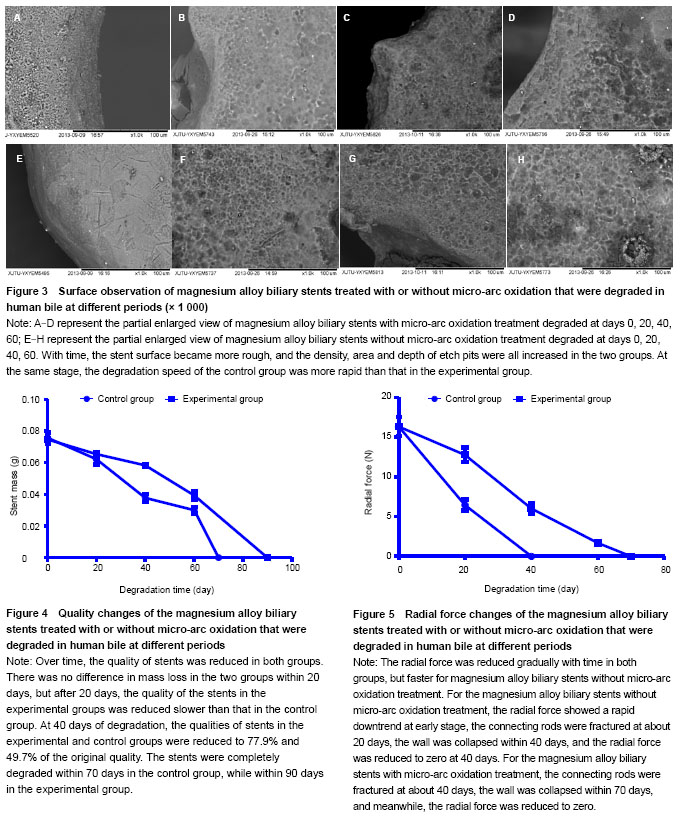Magnesium is considered to be a green engineering material in the 21st century, and magnesium alloys are mixtures of magnesium with other metals. Because of excellent biocompatibility, good biodegradability, good mechanical support performance, easily obtained, and low prices, magnesium alloys have the potential to become a biodegradable material. However, the rapid degradation
in vivo [16] limits the clinical application of magnesium alloys. The corrosion resistance of magnesium alloys have been greatlvey improved by the delopment, alloying, rapid solidification technology, surface treatment (chemical conversion coating and organic layer) of high-purity magnesium[17-18]. In this experiment,
we improved the corrosion resistance of magnesium alloys by the surface micro-arc oxidation method. A large amount of studies have been done worldwide in the medical application of magnesium alloys as degradable biomaterials that have been widely used in cardiovascular medicine, orthopedics, stomatology and other fields.
A foreign clinical study has shown that after magnesium alloy stent implantation, coronary angiography and intravascular ultrasound in patients with coronary artery stenosis showed that the incidence of vascular stenosis was significantly reduced, some narrow vessels were increased in diameter, and the blood supply was good, indicating the magnesium alloy stent implantation achieves good clinical efficacy. Zhang et al [19] implant the magnesium alloy rods into the femur of New Zealand rabbits, and these researchers found that magnesium alloys can be used as biodegradable bone fixation materials with good biocompatibility and excellent mechanical properties. However, the magnesium alloys used in the biliary tract are rarely reported. Our experiment for the first time introduced magnesium alloys to the biliary tract, which was designed to observe the degradation rule of magnesium alloy stents in the bile and to assess the possibility of magnesium alloys used in the biliary tract.
In vitro experimental studies on the biliary stents previously reported mostly observed the stents in a static environment, and the dynamic environment of human biliary tract could not be properly simulated, leading to the deviation of the results of in vitro experiments. We adopted a dynamic numerical simulation system that could better simulate the biliary environment, and our experimental results were closer to the stent variation in the body. Currently, the biliary stents made of biodegradable polymer materials are only tubular stents. Here, we prepare the hollowed-out balloon-expandable biliary stents engraved by laser, which have good elastic memory function, is fitted well with the bile duct, and not prone to loss and displacement. The biliary stents in vitro can be compressed that are more easy to pass through the narrow part of the biliary tract, which is more convenient and safer.
Radial force of the stent refers to the radial resistance to external pressure or the strain force to external forces, which determines whether the stent has sufficient supporting role. The radial force is one of the most important indicators of the stents, directly affecting their clinical application[20]. In this study, the universal testing machine for biomaterials was employed to measure the radial force using planar compression method, and the radial force was recorded when the stent displaced
1 mm[21]. This method is simple, easy, and has small error. Our experimental findings showed that the radial force was decreased with degradation time, which was decreased slower in the experimental group than the control group, indicating the magnesium alloy biliary stents with micro-arc oxidation treatment are ongoing to maintain an effective support to meet the clinical requirements of the supporting force of biliary stents.
Compared with previous experimental studies, there is a lot of improvements in the present study. But further studies are required for the clinical application of magnesium alloys (AZ 31B) biliary stents. We used the dynamic numerical simulation system to simulate the human bile environment as far as possible in the following aspects, including biliary internal temperature, pressure, pH, flow rate and other physical and chemical factors. However, there is still a difference from the real human bile environment; to some extent, these differences affect the degradation of magnesium alloy stents. Therefore, animal experiments and clinical trials are necessary to learn more about the degradation of the stent, and improve the experimental data. Previous studies have evaluated the biological safety of magnesium alloys used in cardiovascular medicine and orthopedics, showing excellent biocompatibility[22-26]. But there are no studies on the biocompatibility of magnesium alloy used in the biliary tract. During the gradual degradation of magnesium alloys in the biliary tract, how the degraded products are excreted out of the body and whether it leads to increased blood magnesium concentration and magnesium ion deposition in the local tissue is not clear. Magnesium alloy stents are firstly degraded into large fragments and further degraded into small fragments. Whether these small fragments become the core of biliary stones and then lead to the formation of stones should be further validated by in vivo experiments. Therefore, the further analysis of biological safety of magnesium alloys as biliary stents is necessary, which can provide further experimental basis for clinical application. In this study, the biliary stents were 30 mm in length, 5 mm in outer diameter, 0.3 mm in thickness, which show some differences from the biliary stents used in clinic. The stent size, mechanical properties and degradation law may have a significant impact, therefore which need further research. In this study, the balloon-expandable biliary stents were employed. The stents can be clinically implanted through retrograde cholangiopancreatography under the endoscope, which should be compressed first and open by balloon dilatation. During the implantation process, the stents can be damaged, resulting in changes in their mechanical properties, thereby affecting their function of the stent. Consequently, it should be further verified by clinical trials.
These results suggest that the magnesium alloy stents with micro-arc oxidation treatment can be degraded slower than the bare stents, to achieve the basic clinical requirements of biliary stent degradation time. Magnesium alloys are expected to become an ideal material for novel biodegradable biliary stents.

